Geochemistry of Mudstones/Silty Mudstones from the Qigequan Formation and Shizigou Formation in Yuejin-II Area, Southwestern Area of the Qaidam Basin: Implications for Sedimentary Environment and Sandstone-Type Uranium Mineralization
Abstract
:1. Introduction
2. Geological Background
3. Characteristics of the Sandstone-Type Uranium Mineralization
4. Sampling and Analytical Methods
5. Results and Discussions
5.1. Evaluation on Factors That Control the Final Chemical Components during Diagenetic Process
5.2. Sedimentary Provenance
5.3. Sedimentary Environment
5.3.1. Paleo-Salinity
5.3.2. Paleo-Redox Conditions
5.3.3. Paleoclimatic Conditions
5.4. Implications for Uranium Mineralization
6. Conclusions
- (1)
- The Shizigou Formation and Qigequan Formation exhibit signatures of non-intense alteration, low rock maturity and proximal provenance, with dominantly braided delta front deposition and sand body development.
- (2)
- The overall arid paleoclimatic conditions controlled the sedimentation of large volume of uranium rich materials. The period of relative humidity prompted the sedimentation of reduced agents. The neotectonic-induced slopes and tectonic windows provided pathways for oxygen-rich fluids that infiltrated along permeable layers and extracted the hexavalent uranium and transported in the form of uranyl ion (). When the oxygen-uranium rich fluids entered the reductive sand body, the hexavalent uranium was reduced to tetravalent uranium and deposited in the form of uranium compounds.
- (3)
- Large scale and centrally distributed reductive sand bodies provided favorable ore storage space for certain scale of sandstone-type uranium mineralization in the Yuejin-II area.
Supplementary Materials
Author Contributions
Funding
Data Availability Statement
Acknowledgments
Conflicts of Interest
References
- Hanson, A.D.; Ritts, B.D.; Zinniker, D.; Moldowan, J.M.; Biffi, U. Upper Oligocene lacustrine source rocks and petroleum systems of the northern Qaidam basin, northwest China. AAPG Bull. 2001, 85, 601–619. [Google Scholar]
- Tapponnier, P. Oblique stepwise rise and growth of the Tibet plateau. Science 2001, 294, 1671–1677. [Google Scholar] [CrossRef] [PubMed]
- Rieser, A.B.; Neubauer, F.; Liu, Y.; Ge, X. Sandstone provenance of north-western sectors of the intracontinental Cenozoic Qaidam basin, western China: Tectonic vs. climatic control. Sediment. Geol. 2005, 177, 1–18. [Google Scholar] [CrossRef]
- Yin, A.; Dang, Y.Q.; Zhang, M.; McRivette, M.W.; Burgess, W.P.; Chen, X.H. Cenozoic tectonic evolution of Qaidam basin and its surrounding regions (part 2): Wedge tectonics in southern Qaidam basin and the Eastern Kunlun Range. In Whence the Mountains? Inquiries into the Evolution of Orogenic Systems: A Volume in Honor of Raymond A. Price; Geological Society of America: Boulder, CO, USA, 2007; pp. 369–390. [Google Scholar]
- Yin, A.; Manning, C.E.; Lovera, O.; Menold, C.A.; Chen, X.H.; Gehrels, G.E. Early Paleozoic tectonic and thermomechanical evolution of ultrahigh-pressure (UHP) metamorphic rocks in the northern Tibetan Plateau, northwest China. Int. Geol. Rev. 2007, 49, 681–716. [Google Scholar] [CrossRef]
- Yin, A.; Dang, Y.Q.; Wang, L.C.; Jiang, W.M.; Zhou, S.P.; Chen, X.H.; Gehrels, G.E.; Mcrivette, M.W. Cenozoic tectonic evolution of Qaidam basin and its surrounding regions (Part 1): The southern Qilian Shan-Nan Shan thrust belt and northern Qaidam basin. Geol. Soc. Am. Bull. 2008, 120, 813–846. [Google Scholar] [CrossRef]
- Yin, A.; Dang, Y.Q.; Zhang, M.; Chen, X.H.; McRivette, M.W. Cenozoic tectonic evolution of the Qaidam basin and its surrounding regions (Part 3): Structural geology, sedimentation, and regional tectonic reconstruction. Geol. Soc. Am. Bull. 2008, 120, 847–876. [Google Scholar] [CrossRef] [Green Version]
- Wang, G.C.; Zhang, K.X.; Cao, K.; Wang, A.; Xu, Y.D.; Meng, Y.N. Expanding processes of the Qinghai-Tibet Plateau during Cenozoic: An insight from spatio-temporal difference of Uplift. Earth Sci. J. China Univ. GeoSci. 2010, 35, 713–727, (In Chinese with English Abstract). [Google Scholar]
- Jian, X.; Guan, P.; Zhang, W.; Feng, F. Geochemistry of Mesozoic and Cenozoic sediments in the northern Qaidam basin, northeastern Tibetan Plateau: Implications for provenance and weathering. Chem. Geol. 2013, 360–361, 74–88. [Google Scholar] [CrossRef]
- Yu, P.H.; Ma, J.L.; Liao, J.B.; Li, Z.Y.; Di, J. Geochemistry and paleoenvironment significance of Lulehe Formation/Xiaganchaigou Formation located in the north area of Qaidam Basin. Arid Land Geogr. 2020, 43, 679–686, (In Chinese with English Abstract). [Google Scholar]
- Sang, S.P.; Lu, H.J.; Ye, J.C.; Pan, J.W.; Li, H.B. Sediment Recyclying in the Northern Qaidam Basin Margin during the Cenozoic: A Case Study from the Dahonggou Section. Geol. China 2021. Available online: https://kns.cnki.net/kcms/detail/11.1167.P.20210301.1338.002.html (accessed on 1 March 2021).
- Harrison, T.M.; Copeland, P.; Kidd, W.S.F.; Yin, A. Raising tibet. Science 1992, 255, 1663–1670. [Google Scholar] [CrossRef] [Green Version]
- Chung, S.L.; Lo, C.H.; Lee, T.Y.; Zhang, Y.; Xie, Y.; Li, X.; Wang, K.L.; Wang, P.L. Diachronous uplift of the Tibetan Plateau starting 40 myr ago. Nature 1998, 394, 769–773. [Google Scholar] [CrossRef]
- Zheng, H.B.; McAulay Powell, C.; An, Z.S.; Zhou, J.; Dong, G.R. Pliocene uplift of the northern Tibetan Plateau. Geology 2000, 28, 715–718. [Google Scholar] [CrossRef]
- Wang, C.; Zhao, X.; Liu, Z.; Lippert, P.C.; Graham, S.A.; Coe, R.S.; Yi, H.; Zhu, L.; Liu, S.; Li, Y. Constraints on the early uplift history of the Tibetan Plateau. Proc. Natl. Acad. Sci. USA 2008, 105, 4987–4992. [Google Scholar] [CrossRef] [PubMed] [Green Version]
- Wang, G.C.; Cao, K.; Zhang, K.X.; Wang, A.; Liu, C.; Meng, Y.N.; Xu, Y.D. Spatio-temporal framework of tectonic uplift stages of the Tibetan Plateau in Cenozoic. Sci. China Earth Sci. 2011, 54, 29–44. [Google Scholar] [CrossRef]
- Clark, M.K. Early Tibetan Plateau uplift history eludes. Geology 2011, 39, 991–992. [Google Scholar] [CrossRef] [Green Version]
- Ge, J.; Ying, D.; Zhang, Z.; Zhao, D.; Li, O.; Yan, Z.; Liang, Y.; Wu, H.; Oldfield, F.; Guo, Z. Major changes in East Asian climate in the mid-Pliocene: Triggered by the uplift of the Tibetan Plateau or global cooling? J. Asian Earth Sci. 2013, 69, 48–59. [Google Scholar] [CrossRef]
- Zhang, C.; Wang, S.B.; Yu, R.A.; Cheng, Y.H.; Feng, P.; Yu, H. Mesozoic-cenozoic tectonic evolution and uranium source analysis in northwestern Qaidam basin. North China Geol. 2021, 44, 67–73, (In Chinese with English Abstract). [Google Scholar]
- Molnar, P.; England, P.; Joseph, M. Mantle dynamics, uplift of the Tibetan plateau and the Indian monsoon. Rev. Geophys. 1993, 31, 357–396. [Google Scholar] [CrossRef]
- Ramstein, G.; Fluteau, F.; Besse, J.; Joussaume, S. Effect on orogeny, platemotion and land–sea distribution on Eurasian climate change over the past 30 million years. Nature 1997, 386, 788–795. [Google Scholar] [CrossRef]
- Rea, D.K.; Snoeckx, H.; Joseph, L.H. Late Cenozoic eolian deposition in the North Pacific: Asian drying, Tibetan uplift, and cooling of the northern hemisphere. Paleoceanography 1998, 13, 215–224. [Google Scholar] [CrossRef]
- An, Z.; Kutzbach, J.E.; Prell, W.L.; Porter, S.C. Evolution of Asian monsoons and phased uplift of the Himalaya Tibetan plateau since late Miocene times. Nature 2001, 411, 62–66. [Google Scholar]
- Guo, Z.T.; Peng, S.Z.; Hao, Q.Z.; Biscaye, P.E.; An, Z.S.; Liu, T.S. Late Miocene–Pliocene development of Asian aridification as recorded in the Red-Earth Formation in northern China. Glob. Planet. Chang. 2004, 41, 135–145. [Google Scholar] [CrossRef]
- Dupont-Nivet, G.; Krijgsman, W.; Langereis, C.G.; Abels, H.A.; Dai, S.; Fang, X. Tibetan plateau aridification linked to global cooling at the Eocene–Oligocene transition. Nature 2007, 445, 635–638. [Google Scholar] [CrossRef] [PubMed]
- Katz, M.E.; Miller, K.G.; Wright, J.D.; Wade, B.S.; Browning, J.V.; Cramer, B.S.; Rosenthal, Y. Stepwise transition from the Eocene greenhouse to the Oligocene icehouse. Nat. Geosci. 2008, 1, 329–334. [Google Scholar] [CrossRef]
- Kent-Corson, M.L.; Ritts, B.D.; Zhuang, G.; Bovet, P.M.; Graham, S.A.; Chamberlain, C.P. Stable isotopic constraints on the tectonic, topographic, and climatic evolution of the northern margin of the Tibetan Plateau. Earth Planet. Sci. Lett. 2009, 282, 158–166. [Google Scholar] [CrossRef]
- Sun, J.; Ye, J.; Wu, W.; Ni, X.; Bi, S.; Zhang, Z.; Liu, W.; Meng, J. Late Oligocene-Miocene mid-latitude aridification andwind patterns in the Asian interior. Geology 2010, 38, 515–518. [Google Scholar] [CrossRef]
- Zhuang, G.; Hourigan, J.K.; Koch, P.L.; Ritts, B.D.; Kent-Corson, M.L. Isotopic constraints on intensified aridity in Central Asia around 12 Ma. Earth Planet. Sci. Lett. 2011, 312, 152–163. [Google Scholar] [CrossRef]
- Miao, Y.; Herrmann, M.; Wu, F.; Yan, X.; Yang, S. What controlled Mid–Late Miocene long-term aridification in Central Asia? Global cooling or Tibetan Plateau uplift: A review. Earth Sci. Rev. 2012, 112, 155–172. [Google Scholar] [CrossRef]
- Jia, Y.X.; Wu, H.B.; Zhang, W.C.; Li, Q.; Yu, Y.Y.; Zhang, C.X.; Sun, A.Z. Quantitative cenozoic climatic reconstruction and its implications for aridification of the northeastern Tibetan Plateau. Palaeogeogr. Palaeocl. 2021, 567, 110244. [Google Scholar] [CrossRef]
- Zhang, J.X.; Yu, S.Y.; Mattinson, C.G. Early Paleozoic polyphase metamorphism in northern Tibet, China. Gondwana Res. 2017, 41, 267–289. [Google Scholar] [CrossRef] [Green Version]
- Ren, Y.F.; Chen, D.L.; Kelsey, D.E.; Gong, X.K.; Liu, L.; Zhu, X.H.; Yang, S.J. Metamorphic evolution of a newly identified Mesoproterozoic oceanic slice in the Yuka terrane and its implications for a multi-cyclic orogenic history of the North Qaidam UHPM belt. J. Meta. Geol. 2018, 36, 463–488. [Google Scholar] [CrossRef]
- Wang, J.; Wang, Y.J.; Liu, Z.C.; Li, J.Q.; Xi, P. Cenozoic environmental evolution of the Qaidam Basin and its implications for the uplift of the Tibetan Plateau and the drying of central Asia. Palaeogeogr. Palaeoclimatol. Palaeoecol. 1999, 152, 37–47. [Google Scholar] [CrossRef]
- Wang, Y.; Mosbrugger, V.; Zhang, H. Early to Middle Jurassic vegetation and climatic events in the Qaidam Basin, Northwest China. Palaeogeogr. Palaeoclimatol. Palaeoecol. 2005, 224, 200–216. [Google Scholar] [CrossRef]
- Wang, X.; Qiu, Z.; Li, Q.; Wang, B.; Qiu, Z.; Downs, W.R.; Xie, G.; Xie, J.; Deng, T.; Takeuchi, G.T.; et al. Vertebrate paleontology, biostratigraphy, geochronology, and paleoenvironment of Qaidam Basin in northern Tibetan Plateau. Palaeogeogr. Palaeoclimatol. Palaeoecol. 2007, 254, 363–385. [Google Scholar] [CrossRef]
- Miao, Y.; Fang, X.; Herrmann, M.; Wu, F.; Zhang, Y.; Liu, D. Miocene pollen record of KC-1 core in the Qaidam Basin, NE Tibetan Plateau and implications for evolution of the East Asian monsoon. Palaeogeogr. Palaeoclimatol. Palaeoecol. 2011, 299, 30–38. [Google Scholar] [CrossRef]
- Ma, F.; Yang, W.; Zhang, Y.S.; Li, H.Z.; Xie, M.; Sun, X.J.; Wang, P.; Bai, Y.D. Characterization of the reservoir-caprock of the large basement reservoir in the Dongping field, Qaidam Basin, China. Energy Explor. Exploit. 2018, 36, 1498–1518. [Google Scholar] [CrossRef] [Green Version]
- Li, J.; Zeng, L.; Li, W.; Zhang, Y.; Cai, Z. Controls of the Himalayan deformation on hydrocarbon accumulation in the western Qaidam Basin, northwest China. J. Asian Earth Sci. 2019, 174, 294–310. [Google Scholar] [CrossRef]
- Chen, K.F.; Zhou, S.X.; Li, J.; Zhang, C.; Sun, Z.X.; Li, P.P.; Meng, B.K. Geochemical characteristics of natural gas and hydrocarbon charge history in the Western Qaidam Basin, Northwest China. Geofluids 2020, 2020, 2954758. [Google Scholar] [CrossRef]
- Liu, T.; Wang, T.; Zhan, W. Analysis on structural control of coal distribution in the northern Qaidam Basin, NW China. Acta Geol. Sin. 2008, 82, 690–696, (In Chinese with English Abstract). [Google Scholar]
- Zhan, W.F.; Lin, L.; Sun, H.B.; Sun, J.F. Tectonic evolution and structural control of coal in northern margin of Qaidam Basin coal-bearing zone. Coal Geol. China 2008, 33, 500–504, (In Chinese with English Abstract). [Google Scholar]
- Lu, J.; Zhou, K.; Yang, M.F.; Shao, L.Y. Jurassic continental coal accumulation linked to changes in palaeoclimate and tectonics in a fault-depression superimposed basin, Qaidam Basin, NW China. Geol. J. 2020, 55, 7998–8016. [Google Scholar] [CrossRef]
- Wang, X.T.; Fu, C.M.; Li, H.S. Basin-mountain coupling characters of northern edge of Qaidam Basin and the prospect area for sandstone-host U deposit. Miner. Resour. Geol. 2008, 22, 492–495, (In Chinese with English Abstract). [Google Scholar]
- Liu, W.J.; Dang, H.L.; Huang, G.N.; Huang, X.H.; Liu, B.Q.; Zhang, Y.A.; Wang, W.C.; Qi, L.J. Metallogenic conditions and prospecting target of sand type uranium deposits in the Tuanyushan area of northern Qaidam Basin. Northwestern Geol. 2019, 52, 232–240, (In Chinese with English Abstract). [Google Scholar]
- Liu, Y.; Yang, S.; Yin, Y.P.; Wang, J.L.; Hao, G.Q. Hydrocarbon fluid feature of the Shangyoushashan Formation sandstone in the northwest Qaidam Basin and its relationship to uranium mineralization. J. East China Univ. Technol. Nat. Sci. 2020, 43, 430–436, (In Chinese with English Abstract). [Google Scholar]
- Qiao, J.X.; Zhao, X.G.; Liu, L.; Chen, Q. The relationship analysis of thrust structure and sandstone type uranium deposits at northern margin of Qaidam Basin. J. East China Univ. Technol. Nat. Sci. 2010, 33, 252–256, (In Chinese with English Abstract). [Google Scholar]
- Lian, K.; Zhao, X.Q.; Wang, J.B.; Song, Y. Condition and Potential of Sandstone-type Uranium Metallization in Yuqia Area, Northern Qaidam Basin. Uranium Geol. 2020, 36, 145–155, (In Chinese with English Abstract). [Google Scholar]
- Heath, J.E.; Dewers, T.A.; Mcpherson, B.; Nemer, M.B.; Kotula, P.G. Pore-lining phases and capillary breakthrough pressure of mudstone caprocks: Sealing efficiency of geologic CO2 storage sites. Int. J. Greenh. Gas Control. 2012, 11, 204–220. [Google Scholar] [CrossRef]
- Shi, H.C.; Jiang, C.X.; Sun, M.J.; Liao, Z.B.; Cheng, G.X.; Qi, T.S. Sealing capability assessment of mudstone caprock in the Upper Paleozoic, South Ordos Basin. Pet. Geol. Recovery Effic. 2015, 22, 9–16, (In Chinese with English Abstract). [Google Scholar]
- Zhao, C.Y.; Du, M.L.; Shao, L.Y.; Chen, J.P.; Cheng, K.M.; He, Z.H. Types of organic facies and source rock assessment of the coal-measure mudstone in the turpan-hami basin. Acta Geol. Sin. 2010, 72, 169–179. [Google Scholar]
- Meng, Z.P.; Xian, X.M. Analysis of the mechanical property of mudstone/shale in paralic coal measures and its influence factors. J. Coal Sci. Eng. 2013, 19, 1–7. [Google Scholar] [CrossRef]
- Wang, Z.B. Current status and prospects of uranium geology developments of foreign in-situ leachable sandstone-type uranium deposits. Uranium Geol. 2002, 18, 9–20, (In Chinese with English Abstract). [Google Scholar]
- Jin, R.S.; Feng, X.X.; Teng, X.M.; Nie, F.J.; Cao, H.Y.; Hou, H.Q.; Liu, H.X.; Miao, P.S.; Zhao, H.L.; Chen, L.L.; et al. Genesis of green sandstone/mudstone from middle Jurassic Zhiluo Formation in the Dongsheng Uranium Orefield, Ordos Basin and its enlightenment for uranium mineralization. China Geol. 2020, 1, 54–68. [Google Scholar] [CrossRef]
- Jin, R.S.; Teng, X.M.; Li, X.G.; Si, Q.H.; Wang, W. Genesis of sandstone-type uranium deposits along the northern margin of the Ordos Basin, China. Geosci. Front. 2020, 11, 215–227. [Google Scholar] [CrossRef]
- Spirakis, C.S. The roles of organic matter in the formation of uranium deposits in sedimentary rocks. Ore Geol. Rev. 1996, 11, 53–69. [Google Scholar] [CrossRef]
- Jin, R.S.; Cheng, Y.H.; Li, J.G.; Sima, X.Z.; Miao, P.S.; Wang, S.Y.; Ao, C.; Li, H.L.; Li, Y.F.; Zhang, T.F. Late Mesozoic continental basin “Red and Black beds” coupling formation constraints on the sandstone uranium mineralization in northern China. Geol. China 2017, 44, 205–223, (In Chinese with English Abstract). [Google Scholar]
- Jin, R.S.; Yu, R.A.; Yang, J.; Zhou, X.X.; Teng, X.M.; Wang, S.B.; Si, Q.H.; Zhu, Q.; Zhang, T.F. Paleo-environmental constraints on uranium mineralization in the Ordos Basin: Evidence from the color zoning of U-bearing rock series. Ore Geol. Rev. 2019, 104, 175–189. [Google Scholar] [CrossRef]
- Liu, Z.Y.; Peng, S.P.; Qin, M.K.; Liu, H.X.; Geng, Y.Y.; Zhang, X.; Ding, B.; Xiu, X.Q. Origin and Role of Kaolinization in Roll-Front Uranium Deposits and Its Response to Ore-Forming Fluids in the Yili Basin, China. Geofluids 2018, 2018, 7847419. [Google Scholar] [CrossRef] [Green Version]
- Zhao, L.; Cai, C.F.; Jin, R.S.; Li, J.G.; Li, H.L.; Wei, J.L.; Guo, H.; Zhang, B. Mineralogical and geochemical evidence for biogenic and petroleum-related uranium mineralization in the Qianjiadian deposit, NE China. Ore Geol. Rev. 2018, 101, 273–292. [Google Scholar] [CrossRef]
- Jiang, X.Y. Discussion on the metallogenic conditions of exogenous uranium deposits: Paleoclimatic conditions. Radiogeology 1983, 2, 9–13. (In Chinese) [Google Scholar]
- Chen, D.S.; Liu, W.S.; Jia, L.C. Paleo-climate evolution in China and its contrl on the metallization of sandstone type uranium deposit of Meso-Cenozoic basins. Uranium Geol. 2011, 27, 321–326+344, (In Chinese with English Abstract). [Google Scholar]
- Cheng, Y.H.; Wang, S.Y.; Jin, R.S.; Li, J.G.; Ao, C.; Teng, X.M. Global Miocene tectonics and regional sandstone-style uranium mineralization. Ore Geol. Rev. 2019, 106, 238–250. [Google Scholar] [CrossRef]
- Wu, Z.J.; Han, X.Z.; Lin, Z.X.; Li, Z.N.; Ji, H.; Yin, D.F.; Jiang, Z.; Hu, H. Tectonic, sedimentary, and climate evolution of meso-cenozoic basins in North China and its significance of coal accumulation and uranium mineralization. Geotecton. Metallog. 2020, 44, 710–724, (In Chinese with English Abstract). [Google Scholar]
- Chen, Z.L.; Chen, X.H.; Wang, X.F.; Cheng, H.H. Characteristics of in-situ leachable sandstone-type uranium deposit and preliminary study on ore-forming conditions. Miner. Depos. 2002, 21, 853–856, (In Chinese with English Abstract). [Google Scholar]
- Chen, D.S.; Li, S.X.; Cai, Y.Q. A discussion on research situation and development direction of sandstone-type uranium deposits in the Meso-Cenozoic basin of China. Acta Sedimentol. Sin. 2003, 21, 113–117, (In Chinese with English Abstract). [Google Scholar]
- Jiao, Y.Q.; Wu, L.Q.; Peng, Y.B.; Rong, H.; Ji, D.M.; Miao, A.S.; Li, H.L. Sedimentary tectonic setting of the deposition-type uranium deposits forming in the Paleo-Asian tectonic domain, North China. Earth Sci. Front. 2015, 22, 189–205, (In Chinese with English Abstract). [Google Scholar]
- Zhao, J.F.; Zeng, X.; Tian, J.X.; Hu, C.; Wang, D.; Yan, Z.D.; Wang, K.; Zhao, X.D. Provenance and paleogeography of the Jurassic Northwestern Qaidam Basin (NW China): Evidence from sedimentary records and detrital zircon geochronology. J. Asian Earth Sci. 2020, 190, 104060. [Google Scholar] [CrossRef]
- Li, L.L.; Guo, Z.J.; Guan, S.W.; Zhou, S.P.; Wang, M.Z.; Fang, Y.N.; Zhang, C.C. Heavy mineral assemblage characteristics and the Cenozoic paleogeographic evolution in southwestern Qaidam Basin. Sci. China Earth Sci. 2015, 58, 859–875, (In Chinese with English Abstract). [Google Scholar] [CrossRef]
- Shen, A.J.; Zhu, G.H.; Shou, J.F.; Xu, Y. A research on -N1- clastic rock reservoir in Yuejin Area, Qaidam Basin, Northwest China. Acta Sediment. Sin. 2001, 19, 71–78, (In Chinese with English Abstract). [Google Scholar]
- Guan, P.; Jian, X. The Cenozoic sedimentary record in Qaidam Basin and its implication for tectonic evolution of the northern Tibetan Plateau. Acta Sedimentol. Sin. 2013, 31, 824–833, (In Chinese with English Abstract). [Google Scholar]
- Wang, Y.Q.; Liu, Y.T.; Huang, G.P.; Li, S.M.; Xia, Z.Y.; Gong, Q.S.; Liu, Z.G.; Song, G.Y.; Zhu, C. Paleogene–Neogene Sedimentary System and Oil-Gas Distribution in Western Qaidam Basin; Petroleum Industry Press: Beijing, China, 2014; pp. 1–7. (In Chinese) [Google Scholar]
- Xiao, P.; Tang, C.; Wei, J.L.; Xu, Z.L.; Zeng, H.; Liu, H.J. Sedimentary facies of the Sifangtai Formation in the southern Daqing placanticline and its controls to uranium mineralization. Geol. Surv. Res. 2018, 41, 18–23, (In Chinese with English Abstract). [Google Scholar]
- Xu, Z.L.; Tang, C.; Li, J.G.; Wei, J.L.; Zeng, H.; Xiao, P.; Liu, H.J.; Chen, L.L. Sequence stratigraphy of the Sifangtai Formation and its relationship with uranium mineralization in the Sanzhao depression, northern Songliao basin. Geol. Surv. Res. 2018, 41, 24–31, (In Chinese with English Abstract). [Google Scholar]
- Hu, F.; Li, J.G.; Liu, Z.J.; Zhao, D.M.; Wan, T.; Xu, C. Sequence and sedimentary characteristics of upper Cretaceous Sifangtai Formation in northern Songliao Baisn, northeast China: Implications for sandstone-type uranium mineralization. Ore Geol. Rev. 2019, 111, 102927. [Google Scholar] [CrossRef]
- Cheng, X.Y.; Zhang, T.F.; Cheng, Y.H.; Wang, S.Y.; Tian, J. Paleosedimentary environment evolution of Zhiluo Formation in Tarangaole area, northern margin of the Ordos Basin-evidence from geochemical characteristics. North China Geol. 2021, 44, 1–3. (In Chinese) [Google Scholar]
- Abudukeyumu, A.; Song, H.; Chi, G.X.; Li, Q.; Zhang, C.J. Quaternary uranium mineralization in the Qaidam Basin, northern Tibetan Plateau: Insights from petrographic and C-O isotopic evidences. Ore Geol. Rev. 2022, 140, 104628. [Google Scholar] [CrossRef]
- Taylor, S.R.; McLennan, S.M. The Continental Crust: Its Composition and Evolution GeoSci. Texts; Blackwell Scientific Publications: Oxford, UK, 1985; p. 312. [Google Scholar]
- Singh, P.; Rajamani, V. Geochemistry of the floodplain sediment of the Kaveri River, southern India. J. Sediment. Res. 2001, 71, 50–60. [Google Scholar] [CrossRef]
- Nesbitt, H.W.; Young, G.M. Early Proterozoic climates and plate motions inferred from major element chemistry of lutites. Nature 1982, 299, 715–717. [Google Scholar] [CrossRef]
- Andersson, P.O.D.; Worden, R.H. Mudstones of the Tanqua Basin, South Africa: An analysis of lateral and stratigraphic variations within mudstones, and a comparison of mudstones within and between turbidite fans. Sedimentology 2004, 51, 479–502. [Google Scholar] [CrossRef]
- Fedo, C.M.; Nesbitt, H.W.; Young, G.M. Unraveling the effects of potassium metasomatism in sedimentary rocks and paleosols, with implications for paleoweathering conditions and provenance. Geology 1995, 23, 921–924. [Google Scholar] [CrossRef]
- Fedo, C.M.; Eriksson, K.A.; Krogstad, E.J. Geochemistry of shales from the Archean (3.0 Ga) Buhwa Greenstone Belt, Zimbabwe: Implications for provenance and source-area weathering. Geochim. Cosmochim. Acta 1996, 60, 1751–1763. [Google Scholar] [CrossRef]
- Roddaz, M.; Viers, J.; Brusset, S.; Baby, P.; Boucayrand, C.; Herail, G. Controls on weathering and provenance in the Amazonian foreland basin: Insights from major and trace element geochemistry of Neogene Amazonian sediments. Chem. Geol. 2006, 226, 31–65. [Google Scholar] [CrossRef]
- Schoenborn, W.A.; Fedo, C.M. Provenance and paleoweathering reconstruction of the Neoproterozoic Johnnie Formation, southeastern California. Chem. Geol. 2011, 285, 231–255. [Google Scholar] [CrossRef]
- Mclennan, S.M. Weathering and global denudation. J. Geol. 1993, 101, 295–303. [Google Scholar] [CrossRef]
- Nesbitt, H.W.; Young, G.M. Prediction of some weathering trends of plutonic and volcanic rocks based on thermodynamic and kinetic considerations. J. Geol. 1984, 48, 1523–1534. [Google Scholar] [CrossRef]
- Visser, J.N.J.; Young, G.M. Major element geochemistry and paleoclimatology of the Permo-Carboniferous glacigene Dwyka Formation and post-glacial mudrocks in southern Africa. Palaeogeogr. Palaeoclimatol. Palaeoecol. 1990, 81, 49–57. [Google Scholar] [CrossRef]
- Song, B.; Yan, Q.R.; Xiang, Z.J.; Chen, H.M.; Li, J.L. Petrography and geochemistry of clastic rocks and their constraints on the tectonic setting of the Middle Triassic Pingxiang basin, Southern Part of Guangxi. Geol. Bull. China 2014, 33, 2032–2050, (In Chinese with English Abstract). [Google Scholar]
- Hou, M.C.; Jiang, W.J.; Ni, S.J.; Huang, H.; Luo, W.; Shi, X.; Miu, Z.L. Geochemical characteristic of the lower and middle jurassic clastic rocks in the southern margin of the Yili Basin, Xinjiang and its Constraints on Provenance. Acta Geol. Sin. 2016, 90, 3337–3351, (In Chinese with English Abstract). [Google Scholar]
- Floyd, P.A.; Leveridge, B.E. Tectonic environment of the Devonian Gramscatho basin, south Cornwall: Framework mode and geochemical evidence from turbiditic sandstones. J. Geol. Soc. 1987, 144, 531–542. [Google Scholar] [CrossRef]
- McLennan, S.M.; Hemming, S.R.; McDaniel, D.K. Geochemical approaches to sedimentation, provenance and tectonics. In Processes Controlling the Composition of Clastic Sediments; Johnsson, M.J., Basu, A., Eds.; Geological Society of America: Boulder, CO, USA, 1993; Volume 284, pp. 21–40. [Google Scholar]
- Mclennan, S.M. Relationships between the trace element composition of sedimentary rocks and upper continental crust. Geochem. Geophys. Geosyst. 2001, 2, 1021–1024. [Google Scholar] [CrossRef]
- Zhang, T.F.; Sun, L.X.; Zhang, Y.; Cheng, Y.H.; Li, Y.F.; Ma, H.L.; Lu, C.; Yang, C.; Guo, G.W. Geochemical characteristics of the Jurassic Yan’an and Zhiluo Formations in the northern margin of Ordos Basin and their Paleoenvironmental implications. Acta Geol. Sin. 2016, 90, 3454–3472, (In Chinese with English Abstract). [Google Scholar]
- Yu, D.D.; Zhang, Y.S.; Xing, E.Y.; Zuo, Z.F.; Hou, X.H.; Wang, L.L.; Zhao, W.Y. Petrological characteristics and sedimentary environment of the surface mixed rocks in nanyishan structure, Western Qaidam Basin. Acta Geol. Sin. 2018, 92, 2068–2080, (In Chinese with English Abstract). [Google Scholar]
- Russell, A.D.; Morford, J.L. The behavior of redox-sensitive metals across a laminated–massive–laminated transition in Saanich Inlet, British Columbia. Mar. Geol. 2001, 174, 341–354. [Google Scholar] [CrossRef]
- Tribovillard, N.; Algeo, T.J.; Lyons, T.; Riboulleau, A. Trace metals as paleoredox and paleoproductivity proxies: An update. Chem. Geol. 2006, 232, 12–32. [Google Scholar] [CrossRef]
- Chang, H.J.; Chu, X.L.; Feng, L.J.; Huang, J.; Zhang, Q.R. Redox sensitive trace elements as paleoenvironments proxies. Geol. Rev. 2009, 55, 731–739, (In Chinese with English Abstract). [Google Scholar]
- Broecker, W.S.; Peng, T.H. Tracers in the Sea; Eldigio Press; Columbia University: Palisades, NY, USA, 1982; 689p. [Google Scholar]
- Anderson, R.F.; Fleisher, M.Q.; LeHuray, A.P. Concentration, oxidation state and particulate flux of uranium in the Black Sea. Geochim. Cosmochim. Acta 1989, 53, 2215–2224. [Google Scholar] [CrossRef]
- Calvert, S.E.; Pedersen, T.F. Geochemistry of recent oxic and anoxic sediments: Implications for the geological record. Mar. Geol. 1993, 113, 67–88. [Google Scholar] [CrossRef]
- Hastings, D.W.; Emerson, S.R.; Mix, A.C. Vanadium in foraminiferal calcite as a tracer for changes in the areal extent of reducing sediments. Paleoceanography 1996, 11, 665–678. [Google Scholar] [CrossRef] [Green Version]
- Achterberg, E.P.; Van den Berg, C.M.G.; Colombo, C. High resolution monitoring of dissolved Cu and Co in coastal surface waters of the western North Sea. Contin. Shelf Res. 2003, 23, 611–623. [Google Scholar] [CrossRef]
- Jones, B.; Manning, D. Comparison of geochemical indices used for the interpretation of palaeoredox conditions in ancient mudstones. Chem. Geol. 1994, 111, 111–129. [Google Scholar] [CrossRef]
- Lermanm, A. Lakes: Chemistry, Geology, Physics; Springer: Berlin/Heidelberg, Germany, 1978; pp. 79–83. [Google Scholar]
- Cheng, F.; Guo, Z.J.; Jenkins, H.S.; Fu, S.T.; Cheng, X. Initial rupture and displacement on the Altyn Tagh fault, northern Tibetan Plateau: Constraints based on residual Mesozoic to Cenozoic strata in the western Qaidam Basin. Geosphere 2015, 11, 921–942. [Google Scholar] [CrossRef] [Green Version]
- Bao, J.; Wang, Y.D.; Song, C.H.; Feng, Y.; Hu, C.H.; Zhong, S.R.; Yang, J.W. Cenozoic sediment flux in the Qaidam Basin, northern Tibetan Plateau, and implications with regional tectonics and climate. Glob. Planet. Chang. 2017, 155, 56–69. [Google Scholar] [CrossRef]
- Jin, R.S.; Miao, P.S.; Sima, X.Z.; Li, J.G.; Zhao, H.L.; Zhao, F.Q.; Fen, X.X.; Chen, Y.; Chen, L.L.; Zhao, L.J.; et al. Structure styles of mesozoic-cenozoic U-bearing rock series in Northern China. Acta Geol. Sin. 2016, 90, 2104–2116. [Google Scholar] [CrossRef]
- Li, J.G.; Zhang, B.; Jin, R.S.; Si, Q.H.; Miao, P.S.; Li, H.L.; Cao, M.Q.; Wei, J.L.; Chen, Y. Uranium mineralization of coupled supergene oxygen-uranium bearing fluids and deep acidic hydrocarbon bearing fluids in the Qianjiadian Uranium Deposit, Kailu Basin. Geotecton. Metallog. 2020, 44, 576–589, (In Chinese with English Abstract). [Google Scholar]
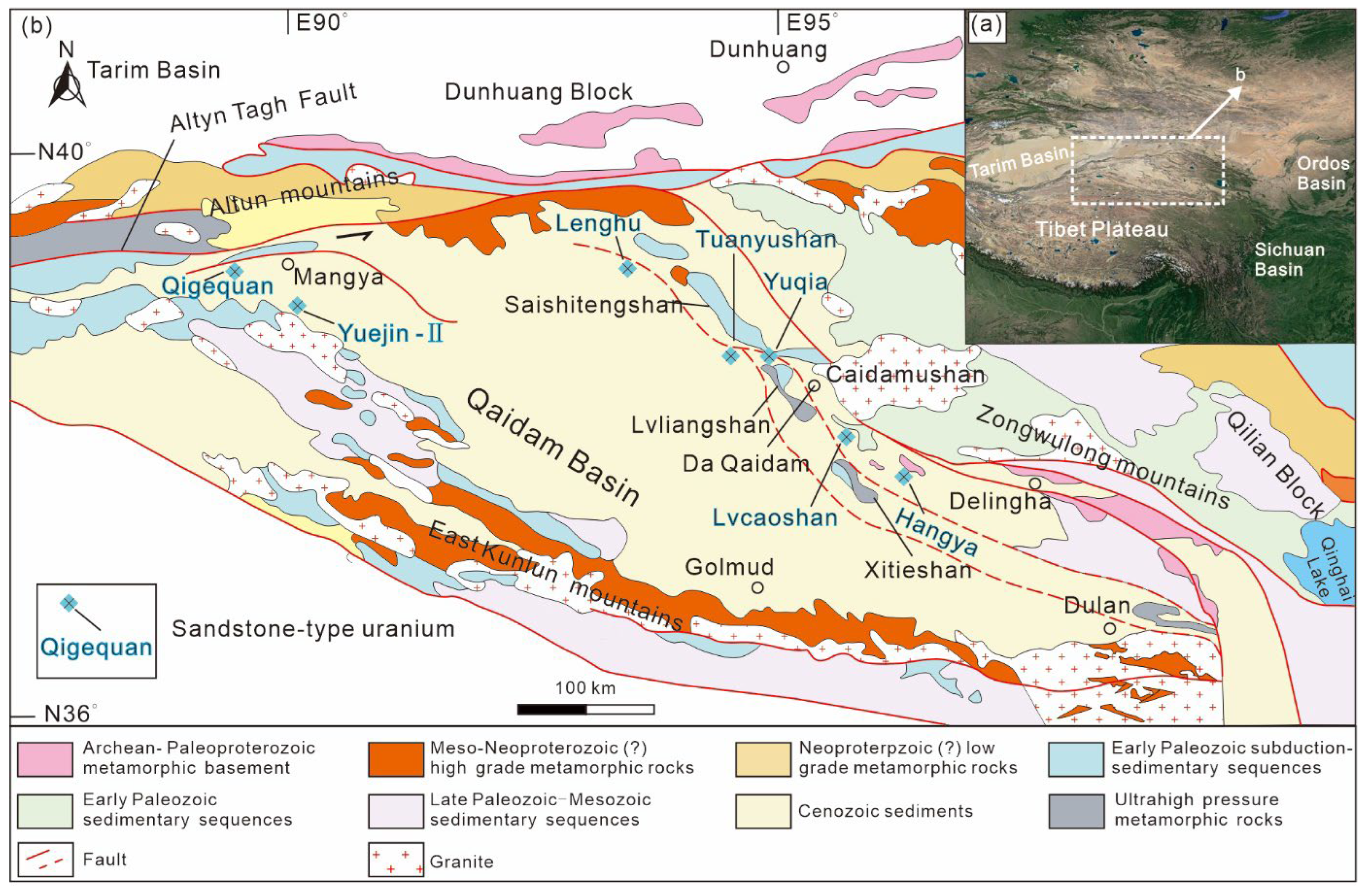
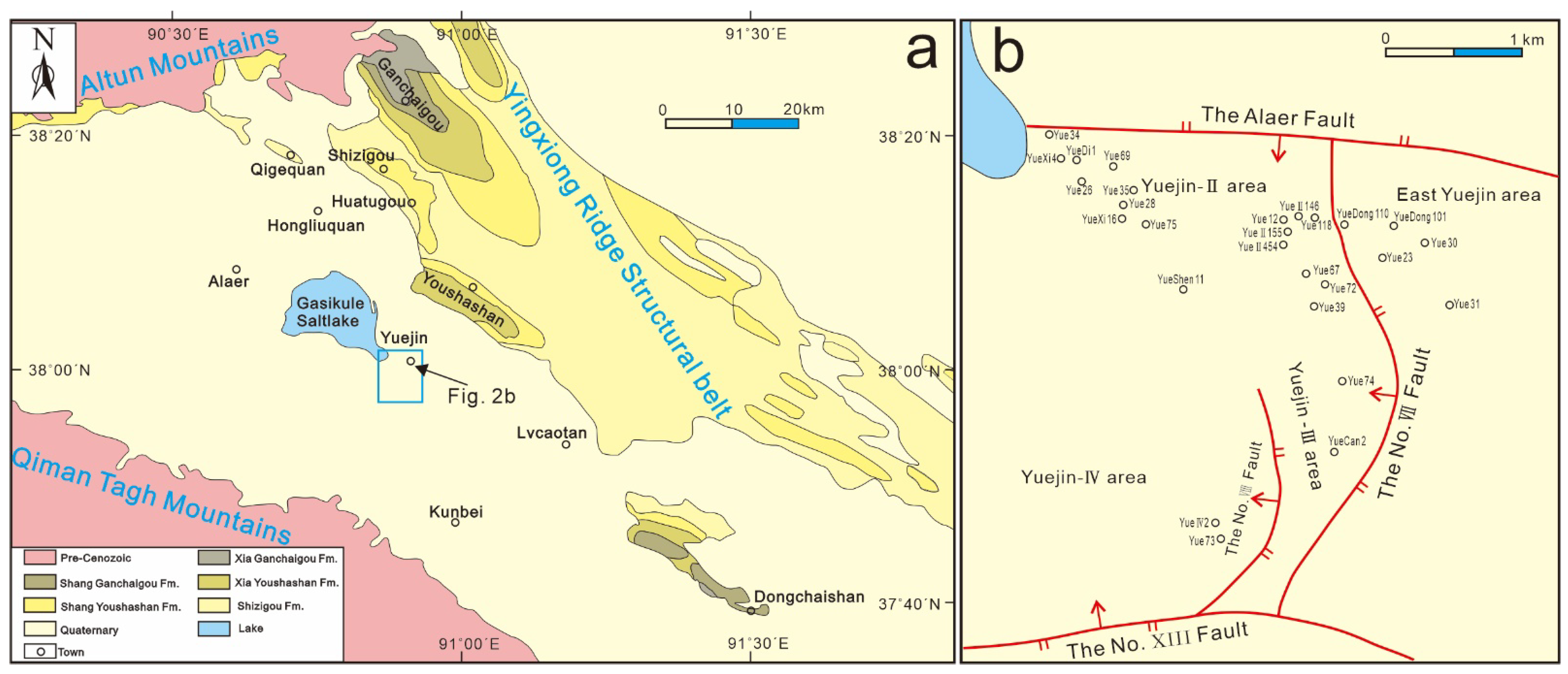
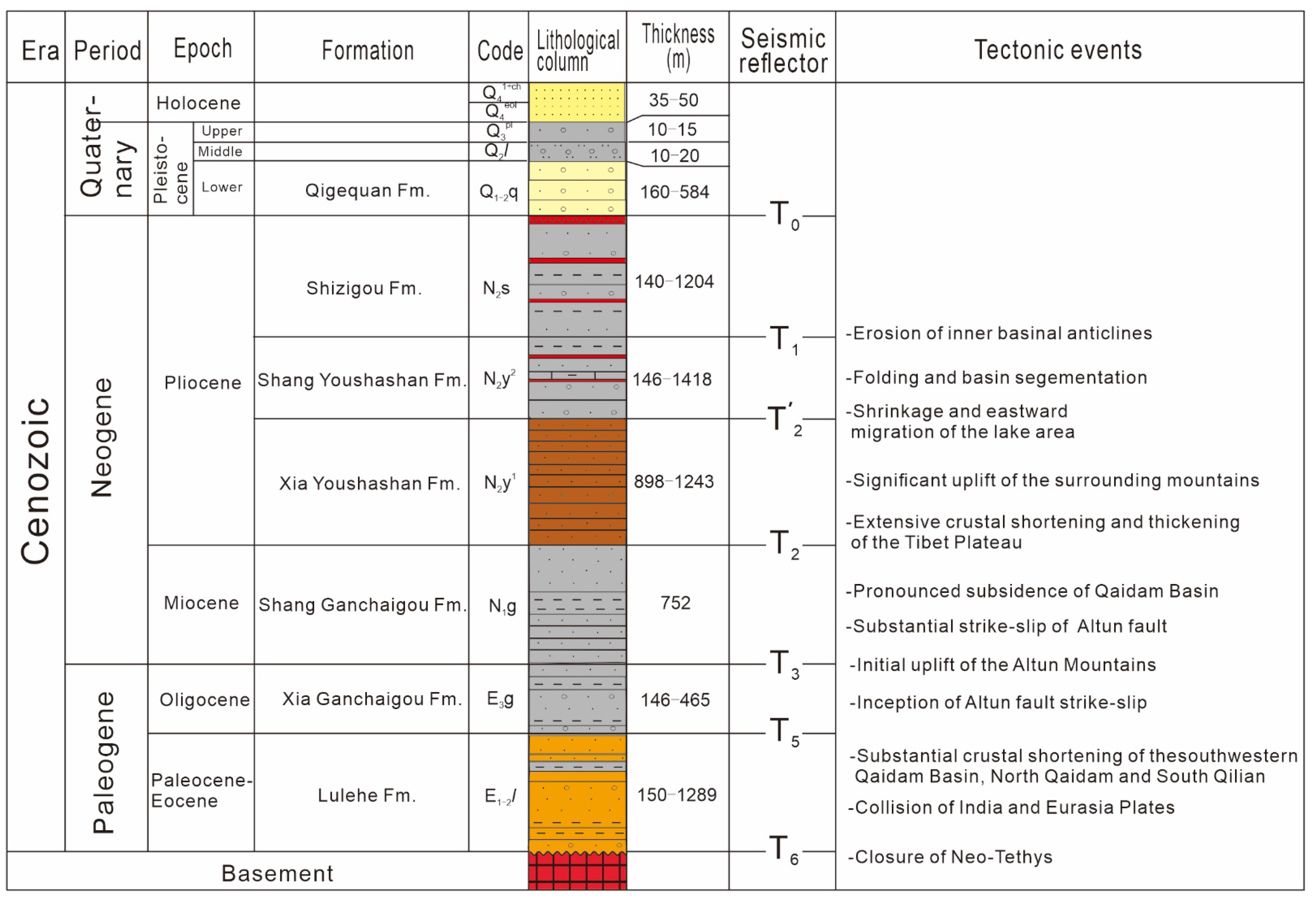

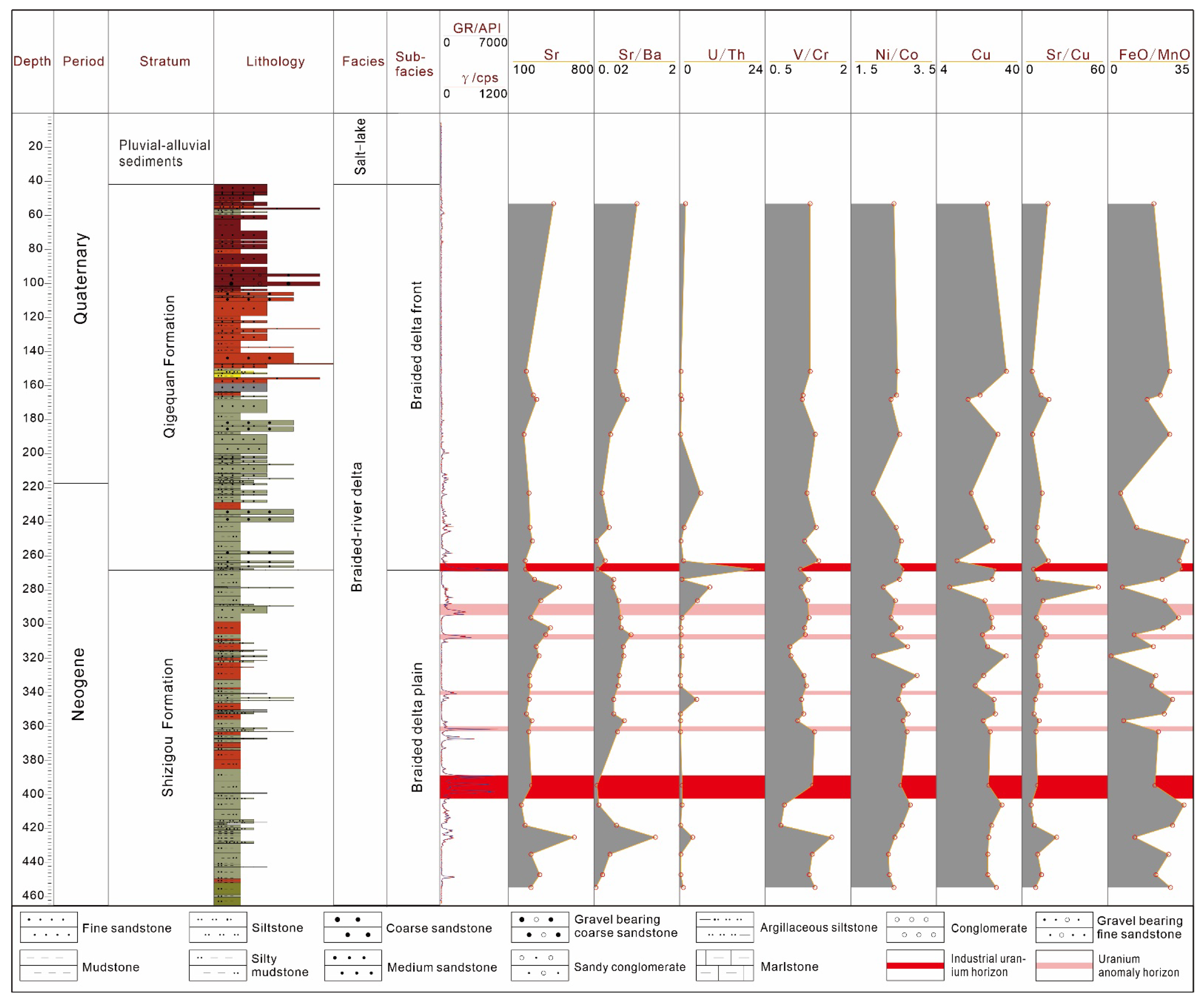
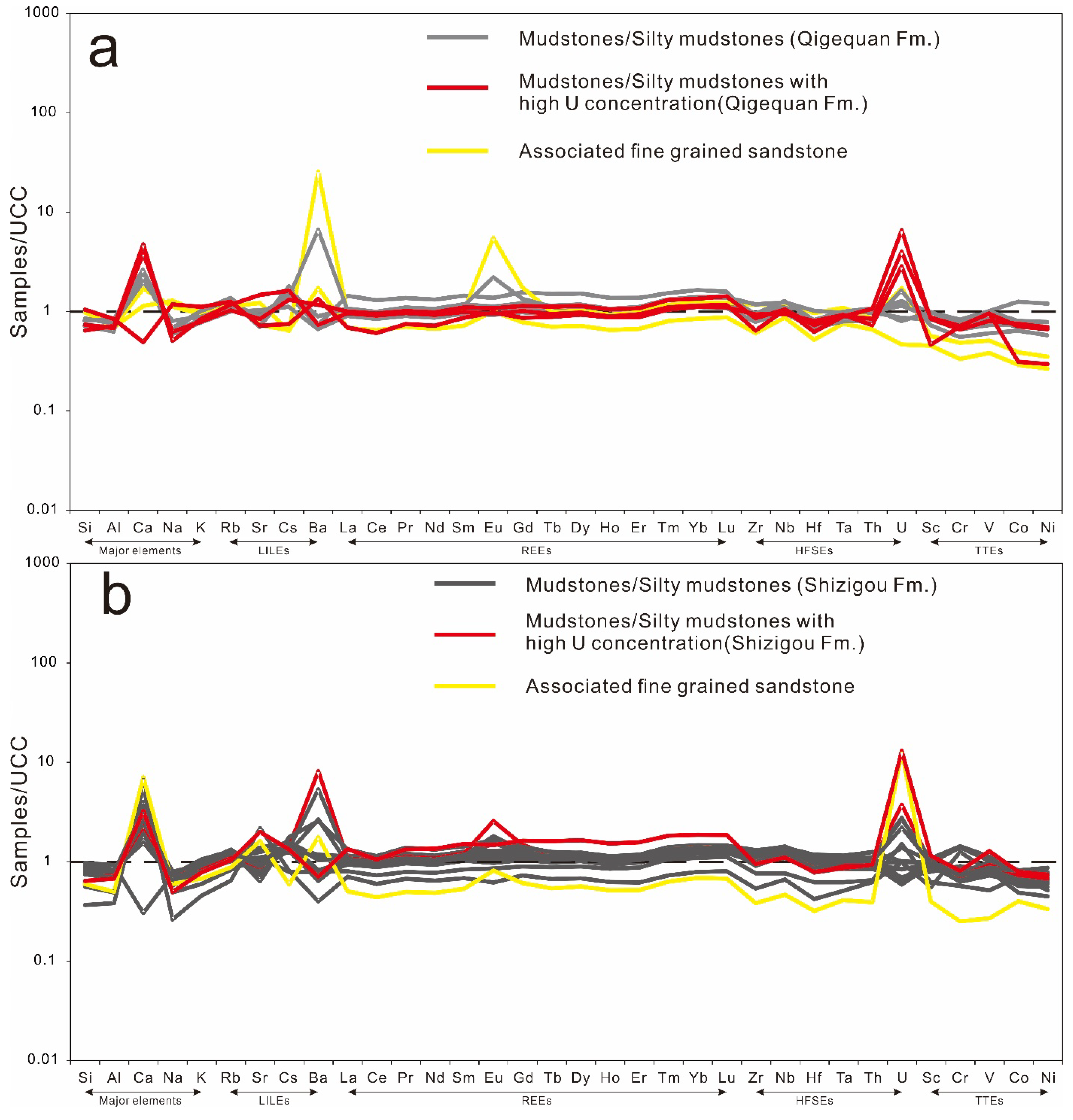
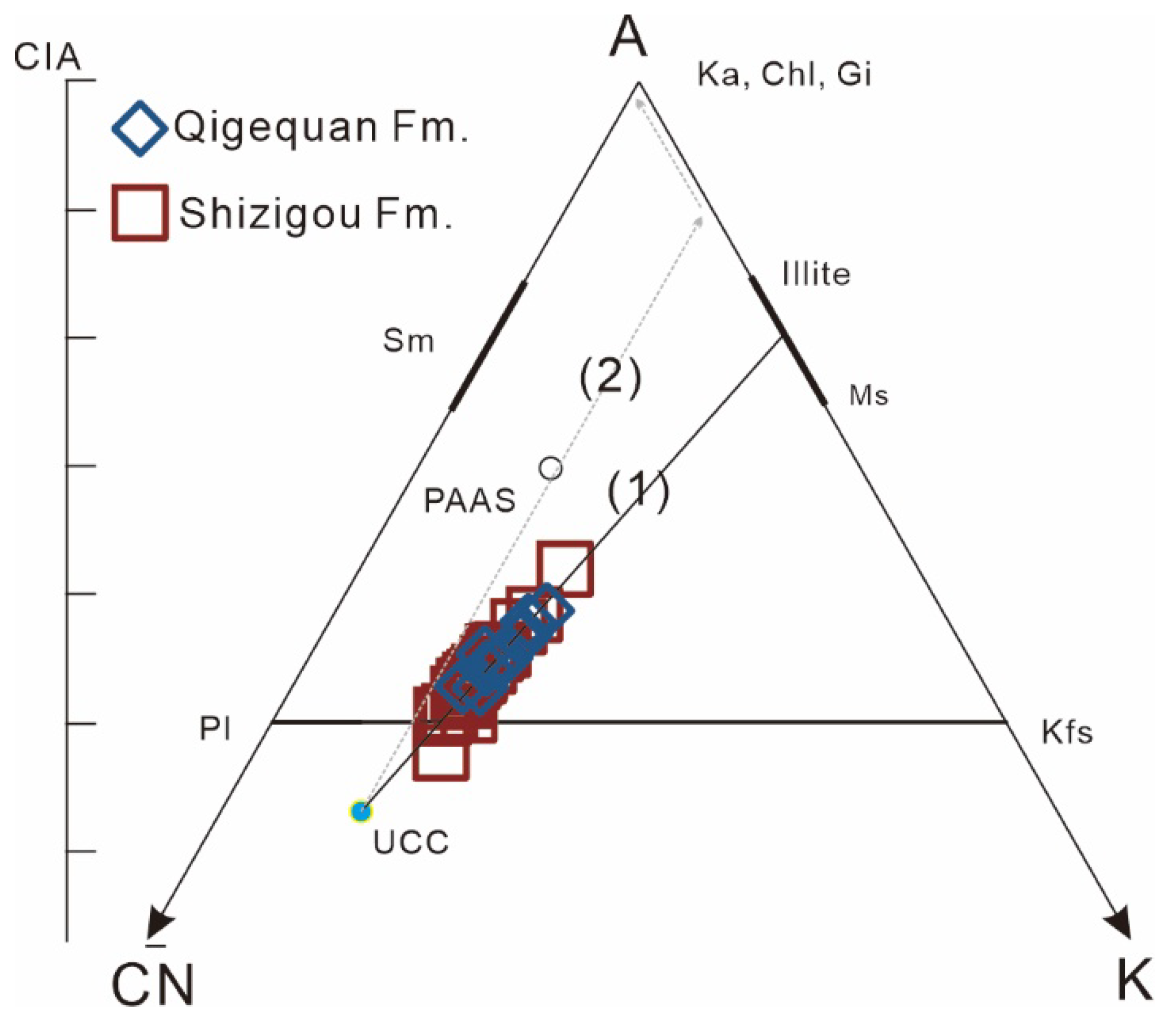
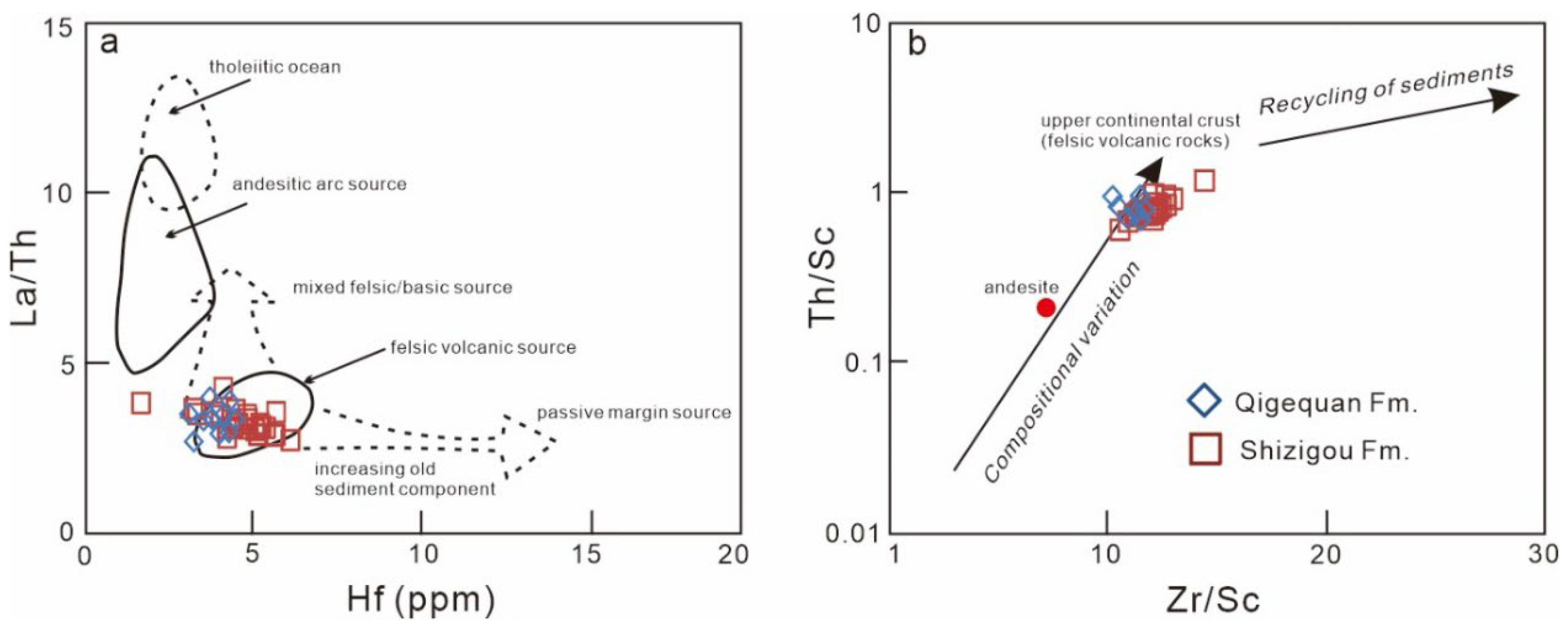
Publisher’s Note: MDPI stays neutral with regard to jurisdictional claims in published maps and institutional affiliations. |
© 2022 by the authors. Licensee MDPI, Basel, Switzerland. This article is an open access article distributed under the terms and conditions of the Creative Commons Attribution (CC BY) license (https://creativecommons.org/licenses/by/4.0/).
Share and Cite
Ao, C.; Teng, X.-M.; Wei, X.-B.; Lei, T.; Wang, D.; Yang, J. Geochemistry of Mudstones/Silty Mudstones from the Qigequan Formation and Shizigou Formation in Yuejin-II Area, Southwestern Area of the Qaidam Basin: Implications for Sedimentary Environment and Sandstone-Type Uranium Mineralization. Minerals 2022, 12, 658. https://doi.org/10.3390/min12050658
Ao C, Teng X-M, Wei X-B, Lei T, Wang D, Yang J. Geochemistry of Mudstones/Silty Mudstones from the Qigequan Formation and Shizigou Formation in Yuejin-II Area, Southwestern Area of the Qaidam Basin: Implications for Sedimentary Environment and Sandstone-Type Uranium Mineralization. Minerals. 2022; 12(5):658. https://doi.org/10.3390/min12050658
Chicago/Turabian StyleAo, Cong, Xue-Ming Teng, Xue-Bin Wei, Tao Lei, Duo Wang, and Jun Yang. 2022. "Geochemistry of Mudstones/Silty Mudstones from the Qigequan Formation and Shizigou Formation in Yuejin-II Area, Southwestern Area of the Qaidam Basin: Implications for Sedimentary Environment and Sandstone-Type Uranium Mineralization" Minerals 12, no. 5: 658. https://doi.org/10.3390/min12050658
APA StyleAo, C., Teng, X.-M., Wei, X.-B., Lei, T., Wang, D., & Yang, J. (2022). Geochemistry of Mudstones/Silty Mudstones from the Qigequan Formation and Shizigou Formation in Yuejin-II Area, Southwestern Area of the Qaidam Basin: Implications for Sedimentary Environment and Sandstone-Type Uranium Mineralization. Minerals, 12(5), 658. https://doi.org/10.3390/min12050658




